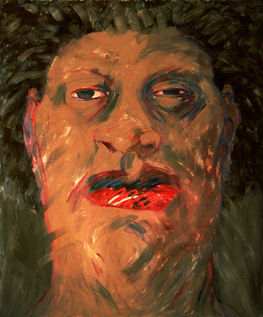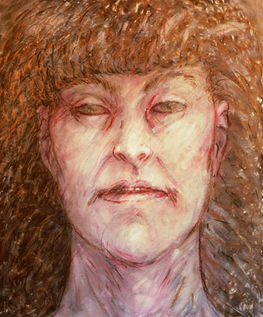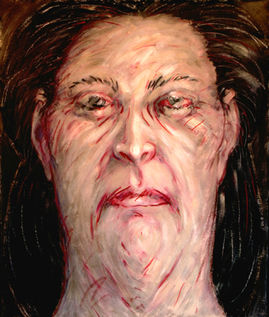She Asked For It, 3 part series

Excerpts from a book about Kay Wood's series of paintings (1980s) protesting violence against women:
She Asked For It
Kay Wood
This book is about gender related violence and about my work as an artist. It is an adjunct to the three series of paintings called She Asked For It, Victims, and Protective Coloration I have been working on for the past five years. It grows out of people’s reactions to the work and their strongly expressed need for explanation and information.
People very understandably want to deny the reality of sexual assault and what its existence means about the relationships between the sexes. To make an attempt at exploring this very painful element of human relations may help towards its alleviation. Before I do so, however, I shall briefly talk about the process of making the art.
My paintings have not always involved political issues. I am fascinated with the myriad aspects of human character. Prior to 1983 I attempted to explore human character through line, form, and stroke. And to explore these elements of painting technique by using the human figure. It seemed ideal to wed my interesting people with my equal interest in the expressive quality of line combined with and played against the brushstroke.
My earlier work explored the whimsical aspects of people with form and line as the prime tools. The painting quality has now evolved into a more specific interest in the balance obtainable with line and stroke and abstract space. The aesthetics of form has been the underlying drive behind all of my work no matter the subject.
In 1983 I came across an article in the Boston Globe which described the trial of one Clarence Burns, who shot his wife, Patti, five times in the face, killing her. Judge Alvin Lichtenstein sentenced Burns to a two-year term in the Denver County Jail for his crime. “The sentence permits Burns to serve his jail term at night only, while continuing to work as a meat cutter... Judge Lichtenstein said in passing the sentence that Mrs. Burns may have provoked her husband to violence by leaving him without warning.”1 Mr. Burns had a long history of brutalizing his wife.
This article led me to create a series of paintings called She Asked For It, a series which now has three parts. I realized that it was impossible to separate myself and my work from the worked around me. If my paintings were to deal with human character, I had to investigate all aspects of it, even the painful ones. Each group of paintings explores a different aspect of the general theme rather that attempting to cover all the very complex issues at once.
Yet Another Incident Reported
The first part of the series is based on real people and events as described in the news media. These paintings are are (49”x60” to 70”x90”) and are acrylic on canvas. They attempt to show the effect of the violent incident on the victim. The assailant gets quite enough sympathy already. This section in the book includes mixed media representations of the acrylic painting combined with the newspaper clippings which inspired them.
Women are People
The second part of the series, VICTIMS, consists of large (70”x60”) oil on canvas portraits focusing on the face. These are a sample of women chosen at random to express the reality that every woman is born a target of male violence and show that victims are individuals with different races, ages, characters, and lives. These paintings are represented here by mixed media drawings accompanied by quotes from various authorities.
Protective Coloration
This third part of the series addresses the personality schism women must undergo to survive in this world. This part shows the subtle but pervasive stress that gender related violence creates in every woman, acknowledged victim or not. The paintings are oil on canvas triptychs jung at different angles over a grid background on a larger canvas.
Blame and Willful Blindness
Only in crimes of male violence against women are the victims blamed for their abuse. No other crime carries this penalty for the victim. A person who gives his wallet to a robber is not told that he should have struggled, he must have enjoyed it, what was de doing there anyway, it doesn’t matter because he has been robbed before, or he’s making it up.
The effects of gender related violence pervade and distort every aspect of human life: child rearing, housing arrangements, job opportunities, transportation, healthcare, marital relations, friendship, and even as simple an act as answering one’s front door. The manifestations begin with birth and end only after death. They cross all boundaries of class, education, and race. All females are potential targets no matter what age or status in life.
Distortions created by the existence of sexual violence show up not only in overt acts of violence but in the daily expressions of inequality. Would men accept the blame for being mugged at a parking lot after visiting a club? Why are women expected to accept as just kidding around acts of pure intimidation? and why do these acts of intimidation win approval?
As I was walking to work a construction worker waved a running chainsaw at me and said “,Come over here and I’ll cut your little titties off.” The other workers - all male - laughed.
When a doctor said to a ninety year-old woman while touching her during a physical exam, “Bet you haven’t had that in a long time.” She could only cringe and go home mortified because she knew that no one would believe her or care. Would an old man ever feel guilty and soiled in her place? Would an old man ever have to experience such shame?
Even the classic, “Smile, Honey,” from strangers is not a greeting but a form of intimidation, marking the woman as territory, and asserting the man’s right to control her behavior. Would two male strangers ever order teach other to smile?
People say to me, “we’ve heard this before. Why are you still bothering? It’s been done already.”
I say, “It hasn’t been done enough. It’s not over.” In America, the land of the free and the brave:
•A rape victim is still guilty until proven innocent.
•According to FBI statistics, a woman is raped every three minutes.
•In the last two decades, incidents of “forcible rape” have quadrupled, not declined.
•Rape is the only crime that is designated by the qualifier “forcible” - i.e, one does not use the term “forcible murder.”
• A woman is battered every eighteen seconds, according to the FBI.
•One-fifth to one-third of all female children are sexually abused.
•At least two million women are beaten every year.
•One out of two women will be attacked in their homes.
•Women still experience sexual harassment on and off the job.
•Four thousand women die every year from domestic violence.
•80% of rapes are planned aggression (disproving the myth that rapes are impulsive acts of uncontrollable sexual urges.)
•Women still have real constraints on the freedom of movement, dress, speech, action, thought and earnings.
Men say to me, “It’s a woman’s problem, I’m not involved.”
I say, “Until sexual abuse is addressed as a human problem - not as a female problem - it will never end. We are all responsible. Until men fully accept their responsibility the victimization of women will continue.”
Men are not inherently evil. It is the relationship of dominance and subordination that breeds abuse, and most importantly it is the belief in the rightness of that dominance that promotes violence. It is the same rationalization in racism, slavery, colonialism, and war. And it uses the same methodology, the process of dehumanization. The connection between male violence towards women and women’s subordination in society is well documented.
The traditional nuclear family and its sexual division of labor and power is the early training ground for the acceptance of dehumanization. Society at large reinforces these lessons with its daily dose of double standards of behavior and acceptance. It is an easy step from learning the inferiority of one person or group of people to believing that all people not exactly like oneself are inferior.
Before the violence will end, we all must learn that different does not mean inferior. We can start by:
•Acknowledging the problem.
•Thinking about our part in the problem, not evading the unpleasantness of reality.
•Expecting men to be responsible for their actions.
•Refusing to think of women as “cunts,” “chicks,” “biddies,” jail bait,” etc.
•Addressing the inequalities in earning power and childcare responsibilities.
•Refusing to blame the victim.
•Refusing to accept the degrading of females as necessary for male bonding and maturation.
© Kay Wood, 1987





















